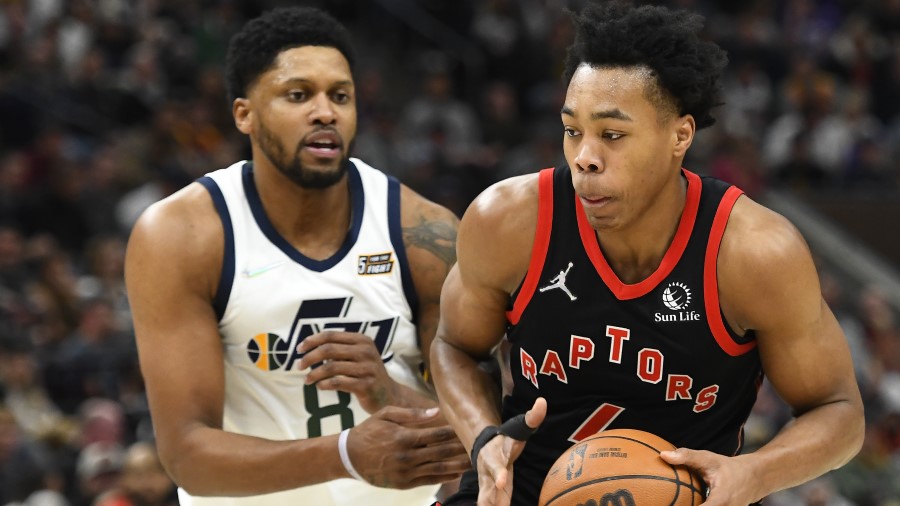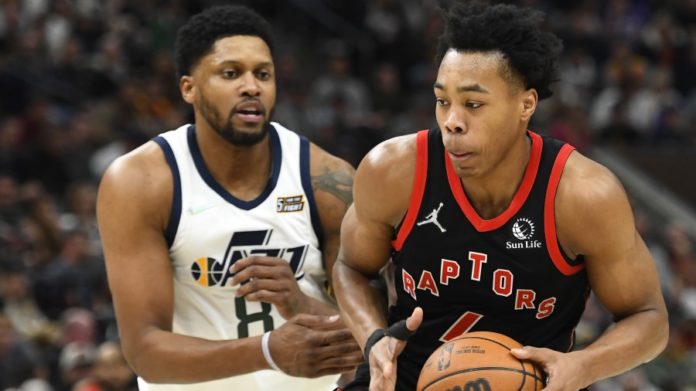
SALT LAKE CITY – Rudy Gay made his presence known in his Utah Jazz debut as the team downed the Toronto Raptors 119-103.
Gay scored 20 points, including five made threes in 18 minutes after missing the first 14 games of the season for the Jazz.
As a team, the Jazz knocked down a season-high 19-46 threes and finished their five-game homestand with a winning 3-2 record.
What Rudy Gay Isn’t
It’s difficult to overstate how good Gay was in his Jazz debut, knocking down a staggering 5-6 threes, and 6-7 overall from the field en route to a team-high 20 points.
The 16-year veteran looked like a dead-eye shooter knocking down corner threes, above the break threes, a three of the dribble, and one three that appeared to be closer to the mid-court line than it did the three-point line.
But it’s worth noting, that probably isn’t what fans should expect from Gay most games. In fact, the forward even said that during his walk-off interview after the game.
“Don’t expect that every night,” Gay told Holly Rowe, “don’t expect that every night.”
With a little research, the smart money says Gay is telling the truth.
First, his 20 point scoring outburst was unique at this point in his career, even considering he has a career average of 16.8 points per game.
Last season in San Antonio, Gay managed to reach the 20 point mark just twice in 57 games, and neither came in fewer than 23 minutes.
Second, this really might have been the best three-point shooting night of his career.
Gay knocked down five threes, matching his career-high, and did so on just six attempts for only the third time in his career.
He also knocked down his one field goal attempt inside the arch, giving him his best single-game shooting percentage in a game that he also made five threes.
Gay will get a ton of open looks inside the Jazz offense, it might be what Quin Snyder does best as a head coach from an x’s and o’s standpoint, so it won’t be a surprise if the veteran sees his career 35 percent three-point rate climb in Utah.
However, it’s equally understandable if Gay fails to have another 5-6 three-point shooting outing during his time in a Jazz uniform, considering he’d done it just twice in the first 1,009 games of his carer, or .002 percent of his outings.
What Gay Is
But while Gay might not be the second coming of Mehmet Okur with his ability to knock down shots at a blistering rate, the other things that should be more consistent from the veteran bring a lot of value to the Jazz as well.
First and foremost, Gay’s size is unique on the roster, and that was apparent from the second he stepped on the floor.
Though Bojan Bogdanovic plays a similar position to Gay, he’s a full one inch shorter and 25-pounds lighter than the 16-year vet.
While Gay may not knock down threes at an 83 percent rate all season, his career 35 percent rate is more than good enough to demand that a defender stays with him at all times.
And, with his height and high release, that mean’s the opposing defense has to assign a bigger defender to Gay if they want to prevent him from shooting the ball. The Raptors learned early in Gay’s minutes that the forward is a willing shooter over a smaller defender, and opted to keep one of their larger wings on him for most of the game.
Assigning that length to a player standing 30+ feet away from the hoop means there is one fewer space-eater to play defense inside the arch, which made the Jazz offense run much more smoothly throughout the night when Joe Ingles was sharing the floor with Gay and Rudy Gobert.
It’s no coincidence that with Gay making his debut, Ingles also had his best night of the season recording a near triple-double with 10 points, eight assists, and seven rebounds in just 23 minutes.
That added spacing, specifically above the break makes it especially hard for teams to assign multiple big bodies to slow Gobert on the role, and as a result, the big man finished with 14 points on a perfect 7-7 shooting.
Additionally, because of the number of places where Gay can be lined up on the perimeter, he’s a more valuable passer than Eric Paschall whose minutes he absorbed tonight.
“Something as simple as spacing, I think with his height again, he’s able to pass the ball,” Jazz coach Quin Snyder said of Gay.
For the season, the majority of Paschall’s threes have come in the corner where he’s stationed in the Jazz offensive to give him the best opportunity to have success as a shooter.
Unfortunately for the third-year forward, he’s shooting a career-low 27 percent on threes, and yet it’s difficult to pass out of or pass up an open corner look.
Gay knocked down his first corner three of the game, but also knocked down four other attempts above the break. Simply being able to station the forward above the break while bringing a defender with him makes him a dangerous passer, and will open up the corner for the team’s other more proven shooters.
On defense, Gay’s length and weight are also an asset as he showed during the game he’s capable of taking on players in either frontcourt position, even when Gobert gets switched onto a smaller defender.
“Defensively, his length impacts shots,” Snyder said, “even if he doesn’t block a shot.”
Where either Gobert or Hassan Whiteside has been solely responsible for adding length to the Jazz defense in the paint, Gay large frame erases a lot of the remaining room for opposing teams to operate down low.
His shooting will be what stands out for the Jazz in his debut, the simple dynamics of the game that change with Gay’s elite length for his position versus the Jazz other options will pay dividends throughout the year.
Everything Looks Better When Shots Fall
As much credit as Gay deserves for unlocking a new dimension in the Jazz attack, it should also be recognized that everything looks better when shots fall, and everything looks worse when they don’t.
A large percentage of the Jazz fanbase was up in arms after the team’s losses to the Orlando Magic and Indiana Pacers in recent weeks, two games that looked particularly painful on the box score.
The frustration was largely due to the team’s combination of turnovers and defensive rebounds that allowed the less talented opponents to steal two wins early in the season.
But in truth, it was the Jazz 19 percent three-point shooting against Orlando and 28 percent three-point shooting against Indiana that cost them those games.
Against Toronto, the Jazz one again had turnover and rebounding problems, committing a season-high 23 giveaways while also allowing 15 second chance opportunities for the Raptors.
However, because the Jazz hit 19-46 from the three-point line, a lot of those careless mistakes were easy to overlook.
The good news for the Jazz is they’ve shot better than 40 percent in back-to-back games for the first time this season, a sign that their shooting slump to open the year may be subsiding.
But they still need to clean up the unforced errors and hustle plays because while they can be covered up by good shooting, they’ll hurt the Jazz in the long run.







